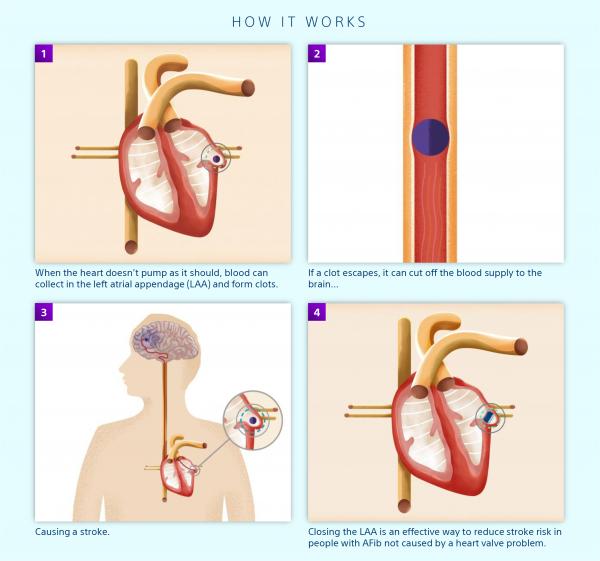Windsocks, broccoli and chicken wings: What is left atrial appendage closure (LAAC) and how does it reduce stroke risk?

September 14, 2022
Picture your heart: a pear-shaped organ the size of your fist, contracting and relaxing at a smooth, even pace. A healthy heart beats at regular intervals, a rhythm that pushes blood through its four hollow chambers in a continuous flow. But what happens when the heart doesn’t maintain its steady beat?
In a condition called atrial fibrillation, the heart beats erratically. This irregular rhythm can cause the blood flow inside the heart to become sluggish. Sluggishly-flowing blood presents a potential danger, because it can form clots – and if a blood clot travels to the brain, it can cause a stroke. Stroke is the number one cause of long-term disability and the third leading cause of death. [i]
Atrial fibrillation is one of the leading causes of stroke. [i] More than 37 million people worldwide had atrial fibrillation in 2017, a 33% increase from 1997. What’s more, the number of people with “AFib” (pronounced “AY-fib”) is expected to grow by more than 60% by 2050, putting even more people at risk for stroke. [ii]
Reducing AFib stroke risk without blood thinners
Atrial fibrillation can’t be cured, but its stroke risks can be reduced in a couple of ways. Taking blood thinners (anticoagulants) is one way to help prevent stroke-causing clots; however, since a major side effect of blood thinners is an increased risk of bleeding, this isn’t an option for everyone. For those who have atrial fibrillation that isn’t caused by a heart valve issue (nonvalvular AFib) and need an alternative to blood thinners, a minimally invasive procedure exists called left atrial appendage closure (LAAC).
Most blood clots that form during atrial fibrillation do so inside the heart’s upper left chamber, within a nook called the left atrial appendage (LAA). The LAA is a small sac that looks slightly differently in each person. The most common LAA shapes resemble a windsock, a head of broccoli and a chicken wing.
LAAC is a procedure that seals off the LAA using a specialized implant like the WATCHMAN FLX implant. The implant is delivered via a tiny catheter snaked into the heart, opening like an umbrella to reveal itself as a flexible ball. The ball is placed with great precision at the mouth of the LAA. After ensuring the fit is snug, the implant is anchored securely to the site and left in place. Heart tissue then grows over the implant and closes off the LAA, preventing blood clots from forming and escaping.
Latest breakthrough treats a wider range of patients
Because every heart is different, the LAAC procedure must be highly personalized for each patient. That’s where the current-generation WATCHMAN FLX implant represents a significant breakthrough. The original WATCHMAN implant, which debuted in 2015, had already been proven safe and effective in treating patients with nonvalvular AFib across the world. However, in the hopes of innovating further and bringing the technology to an even wider range of patients, Boston Scientific decided to give the implant yet another look.
“We wanted to allow even more patients to benefit from the procedure,” says Brian Tischler, director of research and development for the WATCHMAN franchise at Boston Scientific. Over several years and several hundred prototypes, Boston Scientific developed the WATCHMAN FLX implant to be flexible, easily maneuverable, and capable of repositioning, and thus ideal for patients whose LAAs have assumed complicated shapes. Already, the technological advances of the WATCHMAN FLX implant has earned it an “R&D 100” award as an innovation that “will change the industry and make the world a better place in the coming years.”
Most importantly, it makes LAAC implants available to more patients than ever before, enabling them to live healthier lives. To date, the WATCHMAN technology has treated more than 200,000 patients worldwide.
____________
[i] CDC. Public Health and Aging: Atrial Fibrillation as a Contributing Cause of Death and Medicare Hospitalization -- United States, 1999. MMRW Weekly, Feb. 21, 2003 / 52(07);128-131.
[ii] Lippi G, Sanchis-Gomar F, Cervellin G. Global epidemiology of atrial fibrillation: An increasing epidemic and public health challenge. Int J Stroke (2020).